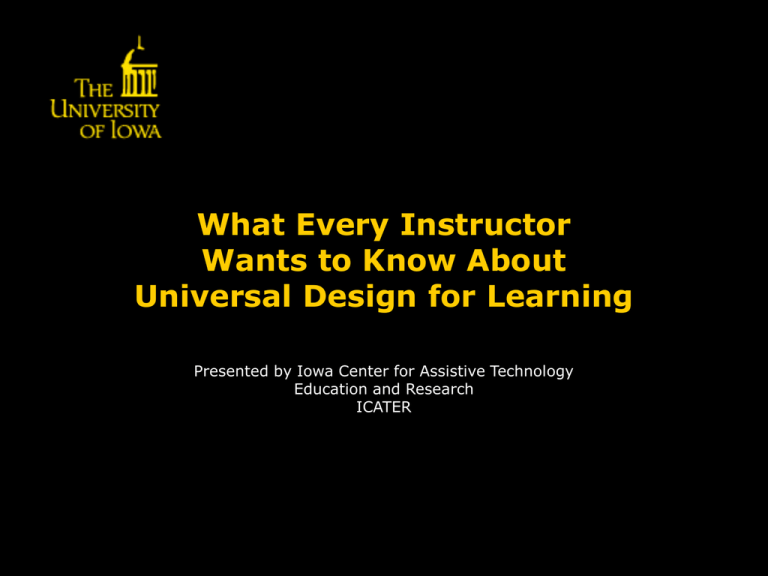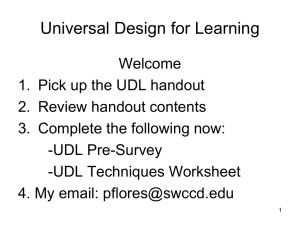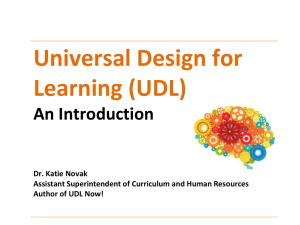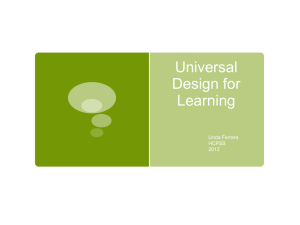What Every Instructor Wants to Know About Universal Design for
advertisement

What Every Instructor Wants to Know About Universal Design for Learning Presented by Iowa Center for Assistive Technology Education and Research ICATER Introduction Hi! I’m Jim Stachowiak, Director of the Iowa Center for Assistive Technology Education and Research, or ICATER. My job is to spread the word about how UDL can make your instructional job more student centered, effective and rewarding. There are a few ideas you will learn about in the next hour that will make you aware of how to anticipate and plan to offer the greatest range of accommodation for all; students with and without disabilities. Universal design is about access without restriction for everyone. For example, we have all seen how curb cuts make it easy to get around town and campus. Access is everything. We take for granted that with the push of a button someone with restricted mobility can easily enter a building. But there is a lot more to universal design than architectural improvements. When you apply many of the same principles to instruction it becomes UD for Learning or UDL for short. The idea is really pretty simple: Make things accessible and usable for all. This deceptively simple principle leads to some interesting and very rewarding strategies for instructors who want to make their courses more student centered and productive for all. There are just a few big ideas to learn about. UDL can make your course a lot more student centered. x Keeping text live is vital to making it available to students the way they can best use it. x Doing it means looking at the classroom environment and the content presentation. x Understanding and applying the principles of Multiple Means of Representation, Expression and Engagement. 1 2 Here’s the game plan: In the second section we will show and tell you about the principles of UDL and give examples. x 3 In the third section we will talk about your classroom environment, and why this is important and what others have done to apply UDL principles. x 4 In the fourth section we will talk about class presentation and the content presentation, and how to get attention and engagement making your course student centered using a variety of pedagogical methods. x 5 In the fifth section we will talk about digital text and how to use it effectively. x 6 In the sixth section we’ll discuss your course syllabus and disability statement and the current situation at Iowa. 7 x In the seventh section we will direct you to resources and cool technology you can incorporate into your course development and where to find how-to guides for making accessible files. Section Two What is Universal Design for Learning? After completing this part you will be able to define universal design and universal design for learning (UDL) and give examples of how you might implement its principles in your courses. x So what is universal design? Universal Design (UD) is defined as the design of products and environments to be usable by all people, to the greatest extent possible, without the need for adaptation or specialized design (The Center for Universal Design, University of North Carolina 1997). x This concept implies that people with disabilities should be able to use universally designed devices or environments successfully without any modifications. People without disabilities should also be able to access these devices or environments normally, without being affected by the accessibility design options. x For example, someone pushing a grocery cart can benefit from an automatic door opener at a grocery store in the same way someone in a wheelchair can. UD concepts are not limited to physical barriers. They also consist of utilizing a variety of sounds, colors, texture, and other stimuli that help make signage and devices accessible to people with sensory impairments. You are already familiar with many examples of UD from curb cuts and automatic doors to fire alarms that have visual signals along with the traditional blaring klaxon and close captioned videos. The increase in the power of these signals to get attention leads us to an important principle that connects Universal Design for Learning to UD. Use multiple sensory modalities for the way you represent the content of your courses, legitimize multiple ways for students to express themselves, and affectively engage them in multiple ways. When used successfully, it provides rich supports for learning and reduces barriers to the curriculum while maintaining high achievement standards for all students (CAST, 2006). Students with physical, sensory, and cognitive/learning disabilities, as well as language barriers, and behavioral or emotional issues are becoming more prevalent in general education classes. To reach all students, teachers need to be able to create lessons that students can benefit from regardless of their individual strengths or weaknesses. UDL concepts help educators customize their curriculum and adapt teaching styles to accommodate individual differences and learning styles (CAST, 2006). A successful UDL-based curriculum consists of three key components. Flexibility: A course that designed with UDL principles adds to a person’s capability. Specific concepts and practices can be applied as needed by each individual. This means the instructor must be flexible, too, in order to convey the importance of this idea in practice. Easy and/or intuitive to learn: Any technology must be relatively easy to set up and training should take a short period of time. In other words, it should be well tested to insure that it is usable. Low physical effort: The environment should be efficient to use and comfortable to use incurring a minimum of fatigue. In addition to the physical space there is the curriculum and the methods by which it is delivered. It is important to understand that a successful UDL-based curriculum consists of the following components: Multiple means of representation (written, picture, audio. etc.) gives learners various ways of acquiring information and knowledge. Multiple means of expression (written, verbal, picture-based, etc.) provides learners alternatives for demonstrating what they know. Multiple means of engagement (books, presentations, simulations, field work, videos, etc.) taps into learners' interests, challenges them appropriately, and motivates them to learn. ACTION Think of a course in which you learned a lot. What factors do you feel contributed to your learning? Tell us why that course was effective. Enter text for item 1 here. Providing multiple means of information representation, expression options, and engagement allows teachers to reach students regardless of their abilities. Review what you’ve learned. In school settings, information is typically provided through verbal presentation and print. Students are expected to listen and write answers in the form of worksheets, papers and tests. Give three examples of universal design. However, some students may have difficulty accessing information or reading books because of: Give an example of a means of representation, of expression, or engagement. a visual impairment a learning disability a language barrier a lack of attention span for reading Other students may have difficulty writing answers to questions due to a physical disability inhibiting their ability to grasp a pencil, or move their hand to write. Students in these situations would best be served in a UDL environment, where accessible options are available. Enter text for items 2 & 3 here. Section Three Creating an Accessible Physical Environment After completing this section you will know how to make your course student centered and assess the accessibility of your classroom environment. Use these points to guide designing your course with a single overarching goal in mind: Make your instruction student centered. Let’s explore a few ways to make your course more student centered. Provide constructive feedback on assignments and assessments. Ask for feedback on instruction. Describe scaffolds to support learning, including technology to enhance learning for all. Retire scaffolds to indicate mastery as performance criteria is attained. Describe teaching methods (pedagogy) that accommodate multiple learning styles and abilities, experience and student background. Describe examples of multiple paths to all course goals and methods (give an example). Promote interaction among students and instructor consistent with the principle of bringing the student into the field’s community of practice. Provide multiple ways for students to contact you such as email, face-to-face, instant messaging, and phone calls. Doing this means all students will have a method they are comfortable with to work with you. The Classroom Environment No matter how student centered your course is on paper, where it counts is the delivery. Students will not be ready to learn if they are unable to navigate the physical space. Ask the following questions to evaluate whether your assigned classroom is accessible. Can every student get into the classroom? Are doors accessible? Can every student navigate the room? This means are the aisles wide enough for wheelchairs, are the chairs and tables, desks or lab benches height adjustable? Does everyone have a choice of where to sit? In many cases students with assisted mobility are consigned to a part of the room that is not amenable to properly hear or see what is going on. Do you know the emergency plans helping students with disabilities evacuate the room? Can everyone see and hear the instructor? Are the accessibility features on the AV equipment on? Here’s an activity to do. Think back to your most recent classroom and based on what you have learned so far, tell us about one thing that stands out as either inaccessible or an adaptation that made the room highly accessible. Review what you’ve learned. Enter text for item 4 here. Download The Physical Classroom Environment Checklist. You may Save it or Save and Print it to use as guide for planning your classroom. ACTION Walk through your assigned classroom using the guide as a checklist. Why might a student in a wheelchair be placed where they can neither see nor hear what going on? List three things you can do to make your classroom accessible. Enter text for items 5 & 6 here. Section Four Applying UDL to the Class Presentation After completing this section will have a good idea of how to make your course student centered using a variety of pedagogical methods. Some of these ideas seem like a lot of work upfront. Indeed, they do require thinking through your course in new terms. But it all comes together if you believe and practice the idea of putting students at the center of your instruction. There are four aspects to class products: Learning Supports Web/media Accessibility Assignments Assessment Determining the Essentials This is the most important part from a teaching standpoint. As each point is presented, take a moment to write in your expectations for a student. Save your responses and compare them to what you might write at the end of the your first semester here at Iowa. ACTION Enter text for item 7 here. What is it that the students must be able to do by the end of this course? What must they know? Why must they be able to do it or know it? In what ways can the student demonstrate that he or she knows the information and can do the task? Learning Supports: Lecture Lecture is not going away, but bear in mind the cognitive load some students face when they encounter unfamiliar material and how you can help increase their understanding of the content. Provide a guide. Have notes available on the course website in advance and make them accessible documents. Pause and ask for questions. This is effective if students see you as truly considerate of all learners. Incorporate natural scaffolds into the presentation. Learning Supports: Video Videos are great when a showing sequence of actions. It helps increase retention of concepts that are amenable to visual presentation. Placing them on the course website makes them available anytime. Use captioned videos Helps all types of students Students with hearing impairments Students with language barriers Students in noisy rooms Provide transcripts Learning Supports: Use pedagogical methods that enable students to express themselves from their areas of strength. Establish a dialog with you to find out how they might best express themselves. Discussions can be done live or online. Some people prefer online and can demonstrate their ability and knowledge without the social constraints that may inhibit them otherwise. Group work can be done in or out of class, in small or larger groups, and as part of a problem solving approach. Simulations are excellent ways to achieve a high level of realism in which the experience approximates the conditions found but scaffolded to control immersion and develop competence. Simulations also are good for incorporating fieldwork, lab work, and all forms of multimedia. Learning Supports: For example let’s look at the benefits of providing class notes. They are a scaffold that are very useful for studying for tests and projects. Providing them to everyone in the class benefits everyone. Provide a structure for the class (image of a road map). Help students that have difficulty with organization. Help students better prepare for class. Help students locate and understand the important points of class. Learning Supports: Presentation slides can be used for class notes. They are very helpful if they are prepared with an eye to accessibility. Students can use them as a guide for notes. Allows students to focus on class, not mechanical task of writing notes, reducing the cognitive load. Put online before class, save as a Word document to enable access for screen readers. Learning Supports: The key is to match pedagogy to class products. How does the field assess performance? Write down what your field considers a valid index of knowing. ACTION Enter text for item 8 here. Offer opportunities to demonstrate learning. Interactive materials engage students using multiple sensory modalities. Continuous feedback lets students know their status to give you feedback on your instruction. Performance rubrics enable students to plan what level of performance they wish to attain. Extend time for fieldwork or tests. Will permit changes in the setting to facilitate concentration free of distractions or desks inappropriate for left-handers or for open book tests. Scale fieldwork to realistic achievement levels for the semester. Make learning objectives criterion based and scaffolded them to leverage prior learning. Website accessibility Your courses are posted on ICON so its user interface will determine its usability. If you have the skills to set up your own site, consider using a template from CAST or another organization that specializes in UDL. Make sure the organization of material is clear and is consistent with other course materials. Make sure all pictures are accompanied by a alt text tag with thorough description. Link should be meaningful (ex. Class Notes not Click Here) UDL and Assignments This is where your field will help you determine the type of assignments you require. This section fall under the principle of multiple means of expression. What are the performance indexes used by the field? Essays or critical reviews of the literature may offer some students a more robust means of demonstrating their knowledge than multiple choice. Presentations may be multimedia, documentaries, videos or audio recordings. Group projects can be powerful ways to promote the belief systems of a field if teamwork is common. If possible, offer a choice. Section Five Accessible Digital Text When you have completed this section you will know what digital text is and how it is vital to student centeredness. Digital text is a powerful idea. It expands the course to places and times outside classroom hours on the students’ terms but with full accessibility. Digital text represents a powerful general principle: Enter once and use many times. Live data means text can be used in many ways.It can be used in Word files without redundant keyboarding. This is very important for course documents. Accessible to all means it is easily manipulated by individual students. If someone prefers to have it read to him or her a text-tospeech utility is very valuable. Live text can be transformed into different media (sound files or animation, or put to music, or used in many different ways). It can be made larger, the color of the text and background changed to improve contrast Continued on next screen… Digital text is dynamic. Continued from previous screen. Braille is vital to visually impaired who cannot see conventional text. It also means that if possible, choose a textbook that is available in digital form. Digital text accessibility means that the materials you put on the course website must meet certain standards. Inaccessible PDFs and Word files are as useful as faxes. Digital text can be used in multimedia as well as traditional print. Multimedia presentations engage multiple sensory modalities and can be accessed at anytime after the first presentation. The following exercise will help make your multimedia more accessible. ACTION For each pair select the best option. Enter your responses to items 9-16 here. Which background is better? Which is an example of good contrast? How might you emphasize an important point? (Remember some people cannot see color well.) A B A B A BBB * Which example shows sufficient font size? Continued on next screen… Too Big To o Small Digital text can be used in multimedia as well as traditional print. Multimedia presentations engage multiple sensory modalities and can be accessed at anytime after the first presentation. The following exercise will help make your multimedia more accessible. ACTION For each pair select the best option. A sans serif font is often a better choice for legibility. Which slide has about the right amount of content? Which provides the best description for a picture? Digital text is the cornerstone of good accessibility. Review what you’ve learned. Tell how you might change your course materials to make them amenable to different presentations. Explain why the idea of keyboarding text once and then leaving it ‘live’ is a powerful aid to instruction. Enter text for items 17 & 18 here. Section Six Creating a UDL Syllabus When you have completed this section you will understand the important points of your course syllabus, disability statement, and know some facts about the present situation at Iowa. Your syllabus represents you, your course, and what you value. Students use it in conjunction with the course website as a guide for readings, assignments, links to notes, and discussion. In it students will find all policy-related matters clearly described. As a downloadable document it must be accessible as live text. Typically the first contact students have with your class. It explains the course objectives, requirements, your expectations, location of the class, and schedule. Must include a disability/accommodations statement. This signifies that you are aware of how many students do not register their disability increasing the need for universal design that benefits all. Include institutions language to ensure consistency of representation of policy. Include personal values statement signifying to students your personal conviction that your course is learning and student centered. Provide information in at least two formats. Clearly explain the goals of the class. Provide multiple ways to contact you; office hours, phone and email. Discuss the disability statement in the first class meeting. How does it signify importance to you. Use it to speak to your acceptance of disability. It indicates you are willing to work with all students that have difficulties. Use it to begin building trust with your students. Treat this more as an open invitation for discussion than a statement. Collect a student information card. What should be in this statement? A statement of your appreciation for diversity. An invitation for the student with the documented disability to meet to discuss their needs. Notification that the request must be made in a timely manner. A statement encouraging students to register with the Student Disability Services Office. The table shows tips for reaching all students using a UDL syllabus. Review what you’ve learned. Explain how your syllabus represents your values. What roles does the syllabus play in how students see you and the course? Enter text for items 19 & 20 here. Download a copy of the table. Section Seven Technology and Resources at Iowa We have collected a lot of resources and would like you to take advantage of the materials we have created for instructors. An example of technology that can be used to create a UDL environment is a scan and read program. A scan and read program allows the teacher to provide a written assignment to the class in a format that can be accessed by all students. Students without disabilities can simply read the assignment while students who cannot comprehend the written material (i.e. they may better understand audio material) can scan the assignment into the computer and have it read to them at a desired speed. Other technologies such as programs that aid students who struggle with spelling, need help organizing thoughts, who have difficulty seeing written material, etc. are also available to help teachers create UDL environments. Three assistive technologies we use at Iowa BrowseAloud If your computer already has BrowseAloud, you can hear this entire presentation. The University has a site license for this text-tospeech program. Contact IT Services to install it if the icon is not displayed on your taskbar. Three assistive technologies we use at Iowa SmartPen The SmartPen is an example of a note-taking tool. It records what is spoken at the time you take a note. To replay what was said that accompanies your notes, merely tap the page with the pen and it plays it back. Using the SmartPen, a student can more effectively manage the cognitive load in a lecture–a big help for students struggling with writing or who have ADHD. Try this idea: Provide students with a SmartPen to pass around so that for each lecture a different student takes notes and posts them to the course website. You will very quickly get an idea of how well students are understanding the material before midterms roll around. It also shows students that note taking is a varied affair in which there is no single best method. Resources from ICATER At ICATER we have compiled an edited list of great resources to help you become expert at universal design for learning. We encourage you to browse the ICATER/Universal Access site. Our main URL is: http://www.education.uiowa.edu/universalaccess/index. htm One of the resources we’ve created is a nine-part video of our very own Noel Estrada-hernandez and Jim Stochowiak showing and telling how Noel planned and implemented UDL principles in one of his courses. More resources from ICATER Within the site there are more resources for specific tasks such as creating accessible files: http://www.education.uiowa.edu/universalaccess/tipsheet.htm and on that page are links to specific HowTo Guides: Making Accessible PDFs from scanned documents Creating an Accessible PDF from a Word File Creating Accessible PDF Files with Form Fields We also recommend these sites: Adobe PDF www.adagreatlakes.org Microsoft Word http://ctfd.sfsu.edu/accessibility-resources.htm PowerPoint www.adagreatlakes.org Flash www.adagreatlakes.org




